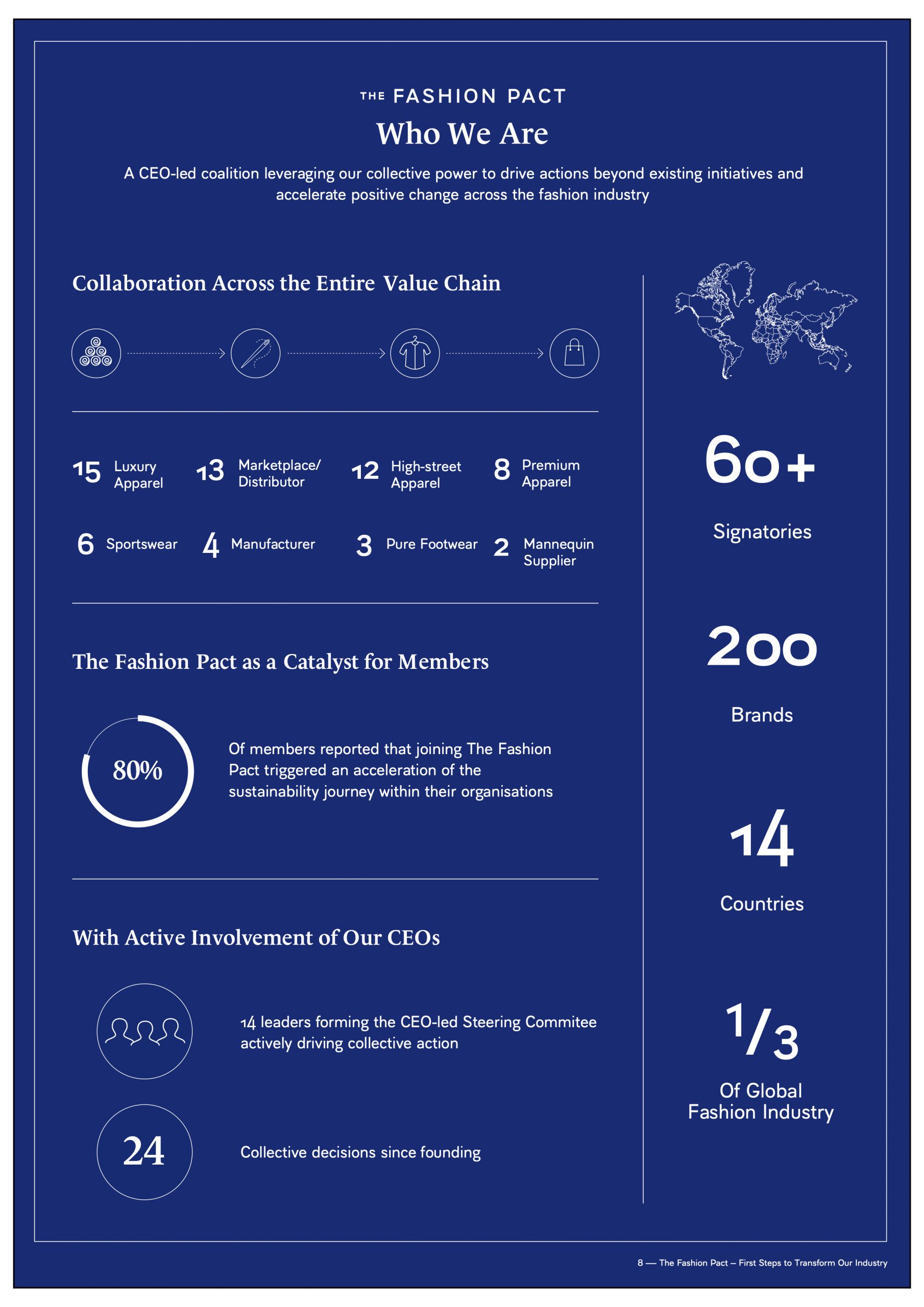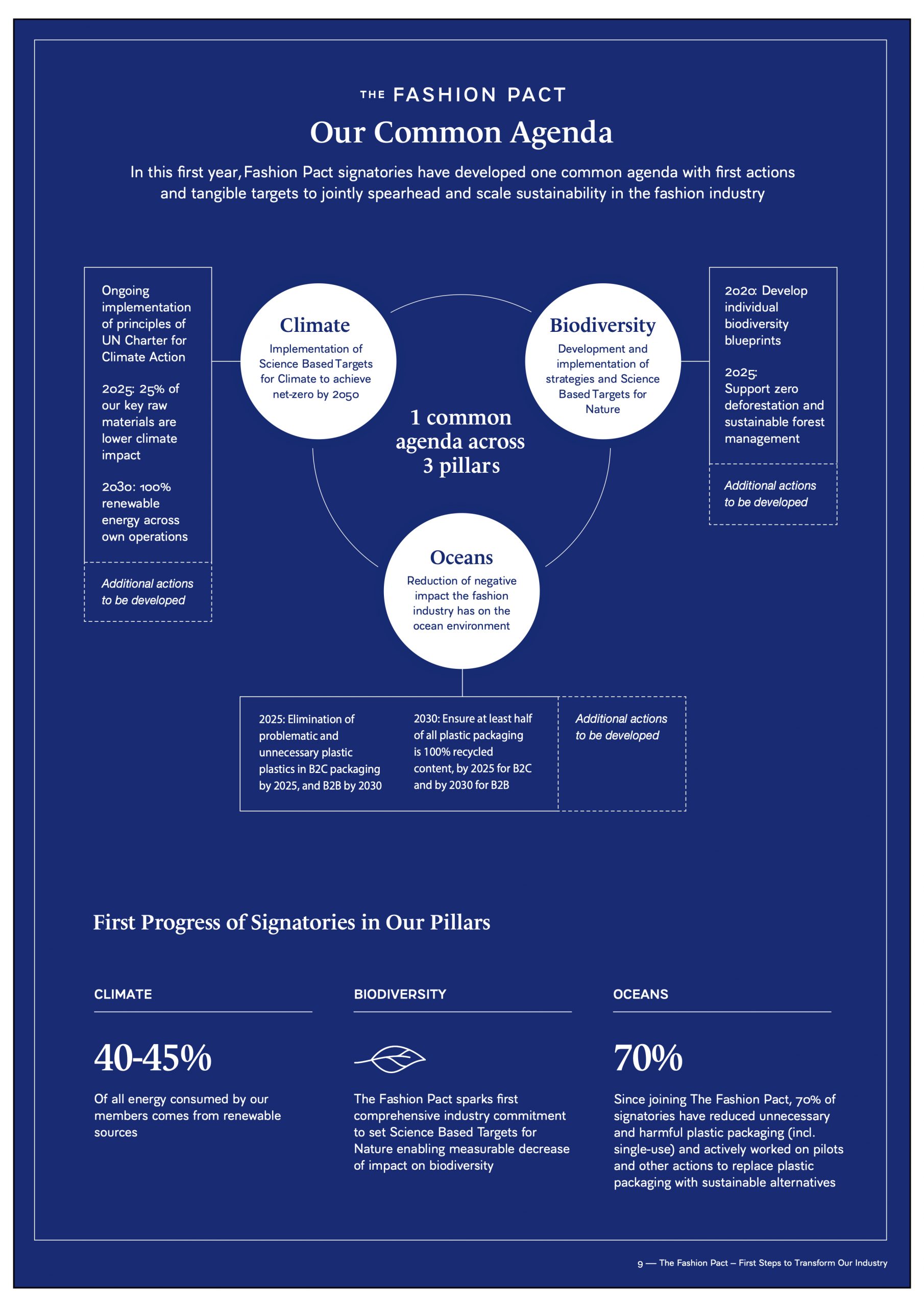The fashion industry is now working on a common goal across corporate boundaries to reduce its environmental impact. At the G7 Summit in Biarritz on August 26, 2019, “The Fashion Pact” launched as a mission given to a committee formed by the CEOs of the fashion industry, led by Kering Group Chairman and CEO Francois-Henri Pinault.
“The Fashion Pact” have been working together to a common core of key environmental goals in three areas: stopping global warming, restoring biodiversity and protecting the oceans. One year later, on October 12, 2020, an update was delivered and discussed the Pact’s one-year progress during Copenhagen Fashion Summit held through the online platform led by Paul Polman, Co-founder of Imagine and Co-Chair of “The Fashion Pact” Steering Committee with executives from PVH Corp., Chanel and Gap Inc. Currently, it unites CEOs of 60+ global leading companies from the fashion and textile industry, about 250 brands, accounting for one-third of the world’s fashion industry. Major global companies such as Kering Group, “Chanel”, “Hermes”, H&M Group, “Nike” and “Burberry” signed up, but there is no Japanese company name.
It can be said that this first year’s report made a little clearer about what will change if you participate in “The Fashion Pact” as Bjørn Gulden, chairman and ceo of Puma, noted in the report. “The Fashion Charter on Climate Action and Science Based Targets are the most important frameworks we have for a meaningful reduction of greenhouse gas emissions. By building upon these initiatives, The Fashion Pact takes the collaborative spirit further, and ensures credible impact and action.”
The morale of the industry has risen, and that is actually reflected in the numbers. Since the inauguration of “The Fashion Pact”, greenhouse gas emissions have been reduced by 350,000 to 450,000 tons. 40 to 45 percent of all energy consumed by members comes from renewable energy sources (in stores, factories, offices and other owned facilities). It is estimated that it will increase to 50% by 2025, aiming for 100% by 2030. In addition, 70 percent of signatories reported reducing unnecessary and harmful plastic packaging. Supply chain improvements have been seen to reduce the carbon footprint by prioritizing transport methods that are more environmentally friendly.
Many brands have begun to change the use of sustainable raw materials. “Prada” started the Re-Nylon project to convert virgin nylon to recyclable nylon ECONYL® fiber. ECONYL® is made by purifying and reusing plastic waste, fishing nets and textile waste collected from the sea. Through the depolymerization and repolymerization process, ECONYL® fiber can be recycled indefinitely without compromising quality. The use of 10,000 tonnes of ECONYL® fiber has saved about 11.2 million liters of oil and significantly reduced CO2 emissions to 65,100 tonnes. The sales of the Re-Nylon capsule collection will be donated to projects related to environmental sustainability.
“Stella McCartney” has maintained the brand spirit of cruelty-free since its establishment in 2001. Two new materials have been adopted for the Fall / Winter 2020 collection. One is KOBA, a bio-fur-free material. Since 37 percent of the material is derived from plants, it has succeeded in reducing energy consumption by up to 30 percent and greenhouse gas emissions by up to 65 percent compared to conventional synthetic fibers. The raw material contains recycled polyester, which can be recycled without disposal after a long life. The other is COREVA, the first stretch denim fabric ever made from 100 percent plant fiber. Made by wrapping organic cotton around a natural rubber core, the biodegradable stretch denim retains its stretch, despite the fact that no plastic or microplastic is used in the fabric.
Not only products and packages, but also fashion show sets are being recycled. “Chanel”, which overwhelms the viewer with a luxurious set, explained their sets such as rockets, cruise ships, Eiffel Tower in the last few seasons are made of recycled materials, and the entire set can be recycled or reused after the show. They also launched “CHANEL Mission 1.5°” based on the Paris Agreement’s goal was adopted in 2015 as an international framework for climate change: pursuing efforts to limit the temperature increase to 1.5°C above pre-industrial levels. Specifically, they set up a gold of reducing emissions per item sold by 66 percent, or reducing emissions per item sold in the supply chain by 40 percent compared to 2018, plus reducing carbon dioxide emissions by 50 percent. “Chanel” invests 25 million euro over the next five years in a project to support small farms and entrepreneurs most vulnerable to global warming, as well as new raw material and packaging development, technology, start-ups, and scientific research on climate change to build a risk-tolerant raw material supply chain.
Among the three areas of “The Fashion Pact”, restoring biodiversity is a relatively recent issue. In the report, only 30 percent of the members noted that they “have mapped their supply chains.” For example, plans to convert destructive raw materials (such as cellulose, which causes a loss of about 15 billion yen) into other environmentally friendly resources, protection of endangered species and the fight against deforestation. “transparency is the key” said Manny Chirico, PVH Chairman and CEO. “This is not just public relations. The industry continues to grow, but ‘The Fashion Pact’ shows that it’s time to change the system, not the time to lose. Because there is no alternative on Earth.”
“The Fashion Pact” will continue to work with external advisors and act on measures to improve the fashion industry. A private digital dashboard for its primary metrics is in development. The end was closed by Paul Polman, Co-Chair of the Fashion Pact Steering Committee. “‘The Fashion Pact’ proves that courageous ceos, acting as one to transform entire industries, can deliver us into a future of harmonious coexistence between nature and business. To those not already on board: All you have to do is join us.”
While great results have been seen in the year, it also shows us these are just the starting points for the ultimate goal. Another concern the updated pact raises is that the top countries exporting fashion are measured by the value, not volume, of exports. European countries occupy the top position in terms of export value, but it follows by Bangladesh, and China in terms of export volume. In short, the relative environmental impact of production in Bangladesh and China could be much higher than Europe. Garment workers in Asian countries have high poverty rates and are exposed to the harmful work environment of wastewater and climate disasters. As “The Fashion Pact” addresses global issues, it seems necessary to focus on efforts in Asia, the biggest problem area.




